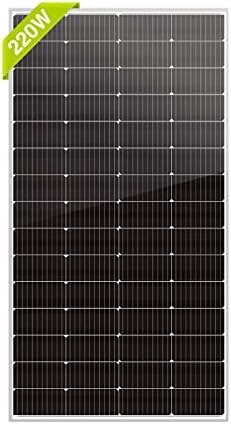### The Pros and Cons of Different Solar Panel Types: Which Is the Most Efficient?
Picture this: You wake up to the gentle hum of nature instead of the blaring noise of a city alarm clock. The soft rays of the morning sun filter through your window, illuminating your cozy off-grid home. You step outside, greeted by the sound of birds chirping and the fresh scent of dew-kissed grass. With a flick of a switch, your home comes to life, powered entirely by renewable energy. How, you ask? It’s all thanks to the solar panels glistening on the roof. Solar energy has transformed how many of us live sustainably, but not all solar panels are created equal. If you’re curious about which type will give you the most bang for your buck—let’s dive in!
#### Understanding Solar Panel Types
Solar panels come in various shapes and sizes, primarily grouped into three main types: monocrystalline, polycrystalline, and thin-film. Each type has its unique characteristics, advantages, and drawbacks. Here’s a closer look to help you unravel which solar technology suits your energy needs.
**1. Monocrystalline Solar Panels**
**Pros:**
– **Efficiency:** Monocrystalline panels are the champions of efficiency. They can convert up to 22% of sunlight into usable energy, making them ideal for smaller spaces.
– **Longevity:** These panels typically have a longer lifespan—often exceeding 25 years—backed by strong warranties from manufacturers.
– **Space-saving:** If you have limited roof space, you’ll appreciate how effective monocrystalline panels are at generating power from a smaller footprint.
**Cons:**
– **Cost:** You’ll likely pay more upfront for monocrystalline panels compared to their counterparts. However, think of it as an investment; the higher efficiency often pays off in energy savings over time.
– **Temperature Sensitivity:** While they perform well in cooler conditions, hot weather can reduce their efficiency slightly.
**2. Polycrystalline Solar Panels**
**Pros:**
– **Affordability:** Generally cheaper to produce and purchase, polycrystalline panels are an attractive option for budget-conscious consumers.
– **Good Performance:** Although slightly less efficient than monocrystalline, they typically have around 15%-20% efficiency rates, which is still good for most residential needs.
**Cons:**
– **Space Requirement:** Their lower efficiency means you’ll need more panels to produce the same amount of energy, which could be an issue if roof space is limited.
– **Temperature Performance:** Polycrystalline panels tend to be less effective in high temperatures, which could result in decreased energy output on particularly hot days.
**3. Thin-Film Solar Panels**
**Pros:**
– **Flexible Applications:** Thin-film panels can be made on flexible materials, opening the door for creative applications, such as integrated solar roofs or solar-powered vehicles.
– **Low Light Efficiency:** They perform relatively well in low-light conditions, so they’re a great option if you live in a cloudy area.
– **Lightweight:** Thin-film panels are typically lighter than traditional panels, which makes installation easier and expands potential applications.
**Cons:**
– **Lower Efficiency:** Efficiency rates hover around 10%-12%, meaning far more panels (and space) are required for the same power output.
– **Shorter Lifespan:** Generally, thin-film panels have shorter lifespans—often warrantied for around 10 to 15 years.
#### Which Is the Most Efficient?
The crown for efficiency goes to monocrystalline panels. If your focus is strictly on maximizing energy output, monocrystalline panels are an excellent choice for power generation in limited spaces. However, your decision shouldn’t solely hinge on efficiency; consider your budget and specific installation circumstances.
#### Making the Right Choice
When choosing a solar panel, it’s crucial to weigh your options against your individual energy needs, location, and budget constraints. Consider how much space you have available, how much sunlight your area receives, and whether you plan to expand your energy production in the future.
#### Pro Tips for Solar Panel Installation
1. **Conduct a Solar Site Assessment:** Evaluate your location to determine how much sunlight your existing roof receives throughout the year. Trees, buildings, or even chimneys can cast shadows that impact efficiency.
2. **Understand Incentives and Rebates:** Familiarize yourself with federal, state, and local solar incentives that can offset the initial investment costs.
3. **Choose a Quality Installer:** Partner with a reputable company that specializes in solar energy installations. Read reviews and ask for referrals to find someone knowledgeable who can guide you toward the best solar panel type for your needs.
4. **Regular Maintenance:** While solar panels are generally low maintenance, it’s beneficial to keep them clean and regularly inspect for debris, especially if you live in a heavily forested area or near the ocean.
5. **Monitor Your System:** Consider installing a monitoring system to keep track of energy production and consumption, making adjustments as necessary.
#### Final Thoughts
Choosing the right solar panel type comes down to balancing efficiency, cost, and your specific energy needs. As you embark on your journey toward a more sustainable lifestyle, remember to weigh the pros and cons of monocrystalline, polycrystalline, and thin-film panels before making your final decision. Each has unique advantages, and the right choice will empower you to harness renewable energy effectively while minimizing your carbon footprint.
Whether you’re a newbie or someone who’s already well-versed in solar technology, understanding the various options available will empower you in your quest for energy independence. Let the sun shine on your future!



